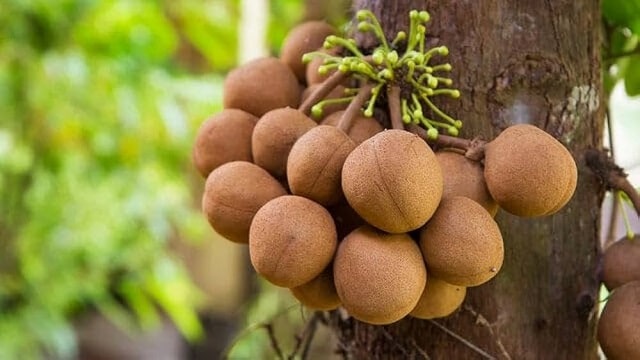Have you ever heard of or maybe tried a fruit kepel? If not, then it’s time for you to get acquainted with this sapodilla-like fruit. He said, Kepel fruit is a fruit consumed by the princess of the Mataram Palace to get rid of body odor.
Once a ‘noble fruit’ in its time, now the kepel fruit is actually less popular and has the potential to become a rare plant, you know!
Get to know the Kepel
Kepel fruit, which has the scientific name Stelechocarpus burahol is a plant that is believed to have originated from Indonesia. It is stated so, because of its natural distribution on the island of Java, especially in Yogyakarta.
In Javanese, ‘Kepel’ means a fist. It is called so, because the size of the kepel fruit is not much different from the palm of the hand holding it. In Sundanese, this fruit is called burahol or turalak, while in English it is known as keppel apple.
Kepel fruit plants are included in the Annonacecae family with a plant height of 6-20 meters. The stems are straight, dark brown in color with the surface having flower and fruit bumps. The diameter of the stem can reach 40 centimeters when mature.
The leaves of the Kepel fruit are single leaf types, aka Folium simplex. The shape is an elongated elliptical-oblongus oblong with a length of 10-28 centimeters and a width of 4-10 centimeters. In addition, the flowers are also unisexual, greenish-yellow, and emit a fragrant smell.
Distribution and environment
The publication in the November 2021 edition of the Journal of the Botanical Gardens stated that the kepel fruit is a tropical fruit that is thought to have originated from Southeast Asia. Indonesia and Malaysia are countries where this fruit is often found. Not only that, Kepel fruit is also spread to the Solomon Islands, even Australia.
In Indonesia, several areas where this plant grows are the Yogyakarta Palace area, Bogor Botanical Gardens, and Purwodadi Botanical Gardens. Then, there are also Taman Mini Indonesia Indah and Taman Kiai Langgeng in Magelang. This shows that the island of Java is the center of kepel fruit diversity, even possible as the area of origin.
Plants from kepel fruit live in lowland secondary forests with an altitude of 600 meters above sea level. Kepel fruit plants need sufficient sunlight. However, kepel can also grow well among bamboo clumps. As for the flowering season occurs in September-October and fruit in March-April.
Kepel fruit and Yogyakarta Palace
The fruit of the kepel got the nickname of the fruit of the palace. Because, this fruit is the favorite fruit of the palace princess and is used for body care. The kepel fruit plant is considered a sacred tree among the Ngayogyakarta Hadiningrat Palace.
It is said that he said, there was a king’s decree requiring this plant to only be planted in the courtyard and high officials at the level of the duke. People do not dare to plant it, for fear of receiving good luck or calamity. That is the reason why kepel fruit plants are only found in the palace environment.
Even after the heyday of the kingdom, this plant is still rare and rare because not many are cultivated. The reason is, they are still reluctant because of habits and customs, and the fruit is considered to have less economic value. So-called, because the flesh is thin and the taste is less appetizing.
Even so, kepel is not a plant that must be protected and has not been listed on the IUCN red list. Some experts categorize Kepel fruit as conservation-dependent, which means that it requires human involvement to make it continue to breed.
Through the Decree of the Governor of the Head of DIY No. 385/KPTS/1992 concerning the Determination of Regional Flora and Fauna of the DIY Province, the kepel fruit plant is used as an identity flora. Full of myths, this plant also has a philosophy of ‘Adiluhung’ which means mental and physical unity and integrity. In addition, it also means ‘unity of will and ambition’ which means the union of intentions with work.
Plant propagation efforts

Although it is still rare and not yet classified as endangered, the Kepel fruit plant can change its status to vulnerable or vulnerable. This condition is even more dangerous if there is no effort to plant and preserve the kepel fruit plant. Propagation of this plant generative or vegetative must be done.
So far, the planting of kepel fruit plants is still prioritizing the generative method, with seed nursery which takes a long time. To germinate, kepel seeds take about 4-6 months without special treatment. The juvenile period lasts 6-9 years, reports National Parks Singapore. Juvenile is the stage of plant development from seed to mature plant and finally flowering.
Vegetative propagation efforts are also carried out. Sadly, propagation attempts by cuttings and aerial layering have been reported to be unsuccessful. Seedlings that grow are also very slow. Plants may not show obvious growth during the first 10 months.
To continue to maintain the Kepel fruit plant, a collection of genetic material for Kepel has been carried out from two distributions in Central Java, namely Karanganyar and Magelang. Furthermore, the plants were planted in an ex situ conservation plot located in the Mangunan area, Bantul Regency with an area of 3.2 hectares.
In addition, efforts to conserve Kepel trees ex-situ are also carried out at the Purwodadi Botanical Gardens (KRP). Since 1965, KRP has collected six numbers of live plants from exploration in East Java, namely from Pasuruan and Malang.
